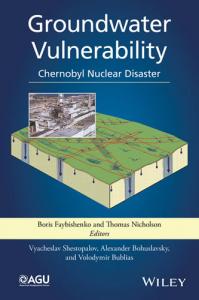Володимир Бублясь » Groundwater Vulnerability: Chernobyl Nuclear Disaster (англ.)
|
[додати інший файл чи обкладинку цього твору]
[додати цей твір до вибраного]
|
Groundwater Vulnerability: Chernobyl Nuclear Disaster (англ.)
Праця
|
|
|
| Написано: |
2015 року |
|
| Розділ: |
Наукова |
|
| Твір додано: |
09.11.2015 |
|
| Твір змінено: |
09.11.2015 |
|
| Завантажити: |
pdf
див.
(3.9 МБ)
|
|
| Опис: |
The Chernobyl Nuclear Power Plant (NPP) accident that occurred in Ukraine on 26 April 1986 was one of the most devastating in human history. The monograph is devoted to the problem of groundwater vulnerability using as a case study the results of long-term field and modeling investigations of radionuclide transport in soil and groundwater within the Ukrainian part of the Dnieper River basin (Kyiv region of Ukraine). The authors provide a comprehensive review of existing literature on the assessment of groundwater vulnerability and then describe an improved methodology developed based on integration of the methods of hydrogeological zonation and modeling of anomalously fast migration of radioactive contaminants from the land surface toward groundwater. The monograph also includes the evaluation of the effect of preferential and episodic flow on transport of radionuclides toward the aquifers and risk assessment of groundwater vulnerability.
© 2015 by the American Geophysical Union
The Chernobyl Nuclear Power Plant (NPP) accident that occurred in Ukraine on 26 April 1986 was one of the most devastating in human history. The monograph is devoted to the problem of groundwater vulnerability using as a case study the results of long-term field and modeling investigations of radionuclide transport in soil and groundwater within the Ukrainian part of the Dnieper River basin (Kyiv region of Ukraine). The authors provide a comprehensive review of existing literature on the assessment of groundwater vulnerability and then describe an improved methodology developed based on integration of the methods of hydrogeological zonation and modeling of anomalously fast migration of radioactive contaminants from the land surface toward groundwater. The monograph also includes the evaluation of the effect of preferential and episodic flow on transport of radionuclides toward the aquifers and risk assessment of groundwater vulnerability.
© 2015 by the American Geophysical Union |
|
| Зміст: |
[натисніть, щоб розгорнути]
Abstract
Introduction: Importance of Lessons Learned from Assessment of Groundwater Vulnerability at Chernobyl
1. Methods of Groundwater Vulnerability and Protectability Assessment
1.1. Method of hydrogeological zoning
1.2. Index methods
1.3. Parametric methods
1.4. Modeling methods
2. Chernobyl-Born Radionuclides in Geological Environment
3. Preferential Flow and Migration Zones in Geological Environment
3.1. State of problem study
3.2. PFMz classification and occurrence
3.3. Methodological approaches of PFMZ study
3.4. Indicators of PFMZ activity in depressions
3.5. Preliminary evaluations of PFMZ influence on upper groundwater
3.6. Practical importance of PFMZ
4. Methodology of Groundwater Vulnerability and Protectability Assessment
4.1. General consideration
4.2. Vulnerability and protectability assessment for upper groundwater (Unconfined Aquifer).
4.3. Vulnerability and protectability assessment for confined aquifers
5. Groundwater Vulnerability and Protectability to Chernobyl-Born Radionuclide
5.1. Upper groundwater
5.2. Confined aquifers
6. Summary
References
Index
|
|
|
|
| |
|
Відгуки читачів:
|
| |
|
Поки не додано жодних відгуків до цього твору.
|
| |
|
|
| |

